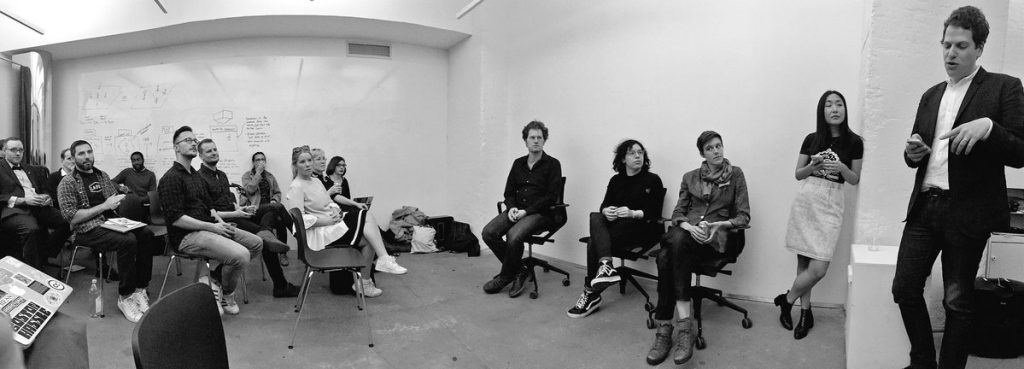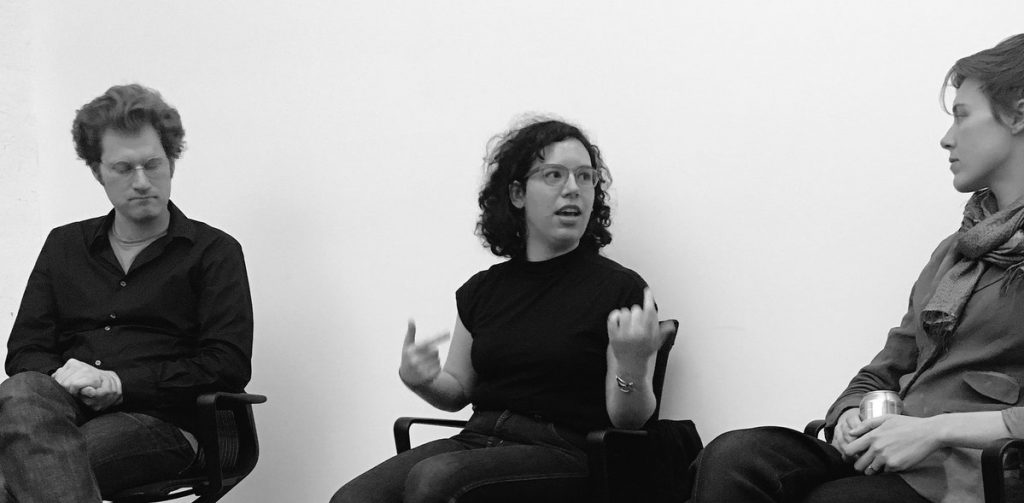Help us protect the commons. Make a tax deductible gift to fund our work. Donate today!

“CC Artists in Conversation @Rhizome” by Kelsey Merkley / CC BY
We’ve been thinking about the role of Creative Commons in 2017, an era where much of digital sharing culture exists within walled garden platforms, with liking and commenting on insta-photos and sharing playlists that can only be streamed. In other words, the web has changed since CC initially launched in 2001, and we are grappling with what these changes mean for CC tools, originally intended to operate in spaces where download and remix were a given. The web is both open and closed, and CC-licensed content exists in both. In some spaces, like research and education, the value CC brings is still the same; CC tools are used to unlock knowledge and advance discovery and innovation. But what about when it comes to unlocking creativity in music, art, media, and emerging multimedia, such as VR, 3D, and software emulations? What value does CC provide in this changing landscape, and how can CC better provide this value?
We asked artists and researchers at the intersection of technology and social change to provide us with their insights last week at Rhizome, a nonprofit dedicated to supporting digital artists and fostering critical discussion about Internet culture. In a room full of artists, arts organizations, and open culture advocates, our featured speakers were:
- Caroline Sinders, Digital Artist, BuzzFeed/Eyebeam Open Labs Fellow, Anti-harassment researcher at Wikipedia
- Michael Mandiberg, Artist working at the intersection of technology and social change, Professor of Media Culture at the College of Staten Island/CUNY, Co-founder of the Art+Feminism Wikipedia
- Caroline Woolard, Artist and founder of cultural equity platforms BFAMFAPhD.com and StudyCollaboration.com, Assistant Professor of Sculpture at the University of Hartford
We framed the conversation as an opportunity to gather fodder for CC’s next phase of work — CC is building a catalog of the commons and seeking to build services on top of this catalog via an API. As part of this project, we have the opportunity to build in features that simplify attribution, express gratitude, and perhaps most importantly, invite collaboration.
We invite you to provide your own thoughts to us in our Slack community and/or by email. We’ll be hosting additional conversations in 2018. What should those conversations explore and where should they be? Let us know, and read on for a recap of our conversation.

“Michael Mandiberg, Caroline Sinders, Caroline Woolard” by Kelsey Merkley / CC BY
In your experience working with CC licensed media, or more broadly any kind of open content online, what factors have most influenced your participation and contributions?
Michael made an important (and surprising for us) distinction between his view of what it means to CC license work and put it out into the world, versus using CC licenses in connection with contributions to a project. In Michael’s experience, these have been two very different acts: where CC licensing work was an individual experience, whereas editing Wikipedia (a CC-licensed project) was a community act. Thus the factors catalyzing creators to CC license a work versus wanting to contribute to a community project are very different.
- Resulting learning for us: How can we bring these experiences more closely together? How can we make it more apparent that CC licensing a work is also a community act because it is a contribution to the commons?
Caroline S. homed in immediately on the community incentive, responding that what motivates her is the community. For her, the community and how it’s governed factors into why and how she contributes. How welcoming is the community? How is it governed — by a community or by a proprietary platform? How safe do people feel in the space? Is the actual contribution part of an ongoing conversation, e.g. live editing? CC-licensing seems embedded in communities like Wikipedia as almost a political act, as users sign on to share and contribute according to a set of open values.
Caroline W. surfaced an incentive that was both individual and communal, with the community act enhancing the individual experience:
“I work collaboratively because thought happens in real time. I want to be in dialogue at all times with people I think are smart. You want to encounter difference at all times and encounter change slowly. It’s harder to work alone.”
What unexpected behavior or community norms have emerged “in the wild,” in spite of the best laid plans/designs? How have these instances informed your thinking and work going forward?
Caroline S. said one unexpected result of making data sets open was the treating and thinking of data sets as “art,” aka digital communication and literacy bringing in a new phase of data literacy. And then further if the data does not represent certain groups, the consequences of using that data set are multiplied.
Caroline W. agreed, saying, “No tool is better than the people,” and that any tool needs to be facilitated by a group of people in order to use the tool appropriately — and even then, one can’t fully control the results. One example of an unexpected result was the piloting of a barter network under the assumption that the community members would govern themselves as a commons. Ultimately, without any facilitation for the tool in place, members treated the network as a zero-sum game, reinforcing capitalist structures that had no original place in the design. To mitigate this, she believes that up front facilitation and a cultural shift that combines online with offline face-to-face meetings is key.
“No tool is better than the people.”
Michael said the more open and collaborative a project is, the more unexpected the outcomes, especially with the micro-relationships underneath the collaborations. For example, Michael highlighted the now infamous issue with the American Women Novelists subcategory that relegated women novelists to a different page than the main page featuring male writers.
Caroline S. said one way to mitigate such occurrences is to have a code of conduct, which would help to establish and articulate norms, and also help define bad behavior. Anytime you’re collaborating with people, this should be clearly defined (rather than simply presumed or implied), and it can be flexible, but still provide some sort of structure.
In response to the opportunity for CC generally, the room chimed in with ideas, such as an analog of CC for codes of conduct, e.g. a community license, or some set of standardized rules. Caroline W. suggested conceptualizing art and design as “open access,” where, like Wikipedia, one could fork and debate edits, and version work as a way to involve the community in the work itself.
We closed the night with a question about sustainability, with regards to both the financial and social life of a project.
Michael pointed out that opening up a work does not inherently makes it sustainable, discussing the stories of two projects that took very different paths: one of them, a technique for making your bicycle reflective, had a longer life, with several derivative projects. The important difference was that project was itself self-sustainable long enough for others to take it and build on it.
Caroline S. said that the question for a sustainable community isn’t so much economic as social; it isn’t whether you are saving people money, it is whether you are creating things that make people feel better and want to get involved. She brought us all back to the meta point about our own research and insights into this field of online communities and behavior, and how outside of this event, the day-to-day work of a designer/researcher in this space is challenging because they have no insight into their counterparts’ research and work at commercial platforms. As such, CC gathering researchers and platform representatives together in the same room is valuable in and of itself!
Posted 30 October 2017